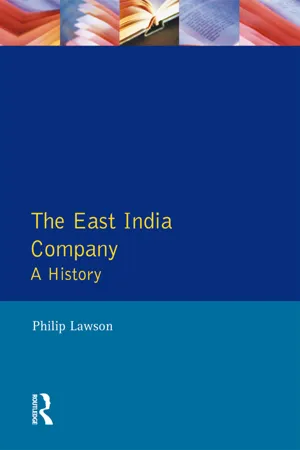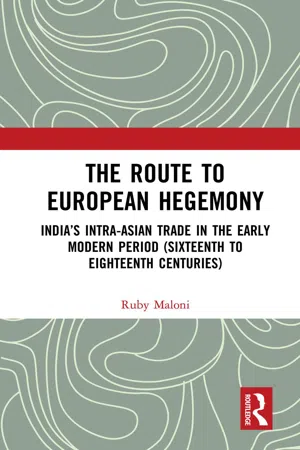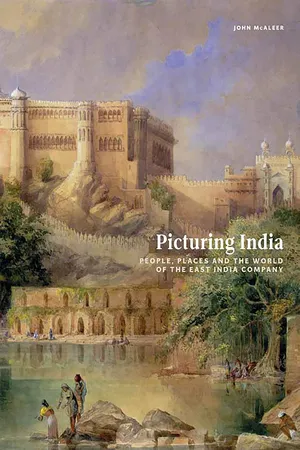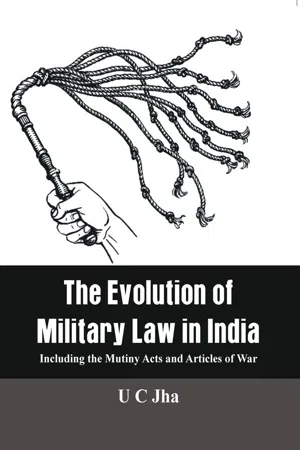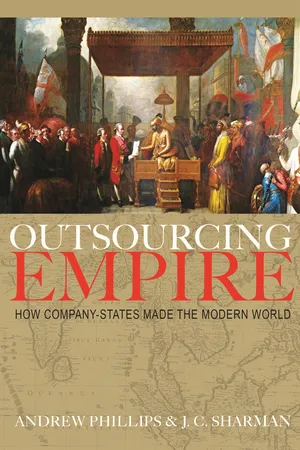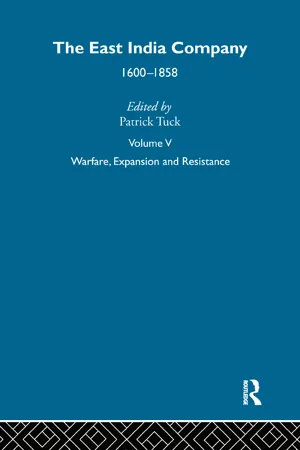History
East India Company
The East India Company was a British trading company established in the 17th century to pursue trade with the East Indies. It eventually expanded its influence and became involved in politics and governance in India. The company played a significant role in the colonization of India and the establishment of British rule in the region.
Written by Perlego with AI-assistance
Related key terms
7 Key excerpts on "East India Company"
- eBook - ePub
East India Company , The
A History
- Philip Lawson(Author)
- 2014(Publication Date)
- Routledge(Publisher)
CHAPTER TWO The Formative Years: 1600–60There has been a tendency in modern scholarship that concerns itself with English expansionism in the seventeenth century to treat the first sixty years of East India Company history as an aside. The push into the northern Atlantic and Caribbean has received more scholarly attention, and, as a result, assumed more importance in both general and specialized studies dealing with early modern European expansionism. It was not always so. In the late nineteenth and first half of the twentieth century several worthy volumes told the detailed story of the perseverance and enduring initiative that turned the East India Company into a world-wide trading and territorial power in the century and a half after its founding (e.g. Hunter 1899–1900 and Foster 1933). The fact that such accounts have been neglected in the post-war world is a matter of regret, but this oversight can be explained by recognizing that such histories presented a picture of England’s past somehow divorced from the mainstream accounts of the nation’s past. The development of the imperial school of history, into which the story of the East India Company fell most readily, created the impression that the Company’s experience belonged solely in the category of overseas ventures that possessed their own imperatives and context.Of late these artificial divisions of the nation’s history have been challenged, and less tolerance shown for delineating the overseas experience as somehow separate from the domestic scene of the early modern period (Lawson 1986; Cressy 1987; Bayly 1989; Bowen 1991). This revision appears a very positive development because it provides a means of marrying the excellent pre-war studies on the East India Company to the more modern pioneering work of social, economic and political historians of seventeenth-century England. Indeed, in what follows it is intended to explore the argument that the East India Company’s formative years are inextricably bound up with mainstream developments in the English state. As England’s fortunes at home and abroad rose and fell, so did those of the Company, and three eras characterize the East India Company’s experience in the first sixty years of its existence. First came two enthusiastic decades in which prospects and optimism about performance appeared at a premium. This era then gave way to two decades (1620–1640) that were not so bright, being smitten with internal and external crises and threats to disband the whole enterprise. The last twenty years of this formative period to 1660 proved unique and complicated to say the least, including as they did civil war and republican government in England. Nevertheless, just when the Company reached the brink of extinction in the 1650s, Oliver Cromwell initiated a new beginning for the eastern enterprise, laying the foundations for future expansion and prosperity. - eBook - ePub
The Route to European Hegemony
India's Intra-Asian Trade in the Early Modern Period (Sixteenth to Eighteenth Centuries)
- Ruby Maloni(Author)
- 2021(Publication Date)
- Routledge(Publisher)
According to Seeley, ‘the history of England was not in England but in America and Asia.’ 61 Kenneth Andrews points out that in the course of English commercial expansion, ‘plunder and settlement were closely interwoven,’with plunder taking pride of place. Between 1550 and 1630 the nation’s shipping tonnage more than doubled, and the special strength of this fleet was its ‘aptitude for warfare and predation,’ as evidenced in the piratical raids of Francis Drake and John Hawkins, and defensively against the Spanish Armada in 1588. 62 For over two and a half centuries, the EIC occupied a crucial position in global maritime trade and politics. It was commonly styled the Honourable East India Company, colloquially referred to as John Company, and in India as ‘Company Bahadur’. It existed for some fifteen years after the 1858 Government of India Act made it an insignificant political player in Indian affairs. The identity and fortunes of this institution fluctuated over the years. Its policies evolved in several directions, not just in the way commonly accepted in historiography, with Plassey as a watershed marking territorial expansion and colonial governance. The pre-Plassey EIC, according to Philip Stern, was not a ‘mere merchant’. 63 Defining sovereignty was of concern to the EIC long before the Battles of Plassey and Buxar led to control over Bengal. In the seventeenth century, the Company already harboured territorial as well as commercial ambitions, evolving governance techniques in the enclaves of Surat, Bombay, Calcutta and Madras. Within its settlements, the Company experimented with English municipal forms. In 1687 it introduced an incorporated council in Madras, modelled after Plymouth, with a mayor and 12 aldermen. Symbolic manifestations of claims to sovereignty included coinage struck by the Company and the pomp and ceremony displayed at factories - eBook - ePub
Picturing India
People, Places, and the World of the East India Company
- John McAleer(Author)
- 2017(Publication Date)
- University of Washington Press(Publisher)
INTRODUCTION The East India Company and British Views of India Eighteenth-century India was ‘the theatre of scenes highly important’ to Britain. 1 So wrote the artist and traveller William Hodges. He was in a good position to judge. Hodges was one of the first British professional landscape painters to visit India, spending six years there under the patronage of Warren Hastings, the most important British official in the subcontinent. As well as painting portraits and creating other works for Hastings, Hodges undertook extensive travels throughout India. And all of these experiences were documented in sketches and drawings, many of which were later worked up into finished oil paintings or published as prints (Fig. 1.1). In matters of trade and war, the Indian subcontinent had assumed an increasingly important role in British political and economic life in the second half of the eighteenth century. This relationship between Britain and India was complex and had its roots in the activities of a London-based trading company. The ‘Company of Merchants of London, trading to the East Indies’ – usually abbreviated as the East India Company – controlled British trade with Asia from its foundation in 1600 until the nineteenth century, and was once described as ‘the wealthiest and most powerful commercial corporation of ancient or modern times’. Any examination of Britain’s relationship with India must take account of this extraordinary organisation. 2 By the time Hodges was working, the Company had become a powerful economic and political player there. And its influence was felt not just in Asia. The Company’s commercial, political and military activities altered the way politicians and merchants in Britain thought about the wider world. Ultimately, it helped to lay the foundations of the British Raj - eBook - ePub
The Evolution of Military Law in India
Including the Mutiny Acts and Articles of War
- U C Jha(Author)
- 2020(Publication Date)
- VIJ Books (India) Pty Ltd(Publisher)
Chapter I The Origin and Growth of East India Company (1600-1858)Towards the end of the fifteenth century rapid discoveries in mathematics, physics, and astronomy facilitated distant navigation. Portuguese explorer Vasco da Gama, in an expedition that began in July 1497, became the first person to sail around the Cape of Good Hope to reach India. His revolutionary route proved that it was possible to reach India without hazardous journeys through the Mediterranean and Arabia. The Portuguese fleets brought lucrative Indian spices to Europe from the East-Indies and filled the treasury of the State. It lowered the price of eastern commodities in the Italian markets, and created a spirit for distant navigation and commerce among the rising maritime states in the north of Europe.1 When the Portuguese acquired seats of trade and dominions on the East and West coasts of the Indian peninsula, they found it necessary to establish guards at their factories, to protect the territories which had been ceded to them by the Native Powers.In 1588, the British acquired naval supremacy after defeating the Spanish Armeda.2 This encouraged a few merchants of London to form a company for trade in the East.3 Queen Elizabeth I of England accepted the proposal to send ships to the Indian Ocean, where Spain was not dominant. A Charter was issued by the Queen on 31 December 1600 which granted the merchants’ newly formed organization: “The Governor and Company of Merchants of London, trading to the East-Indies”4 - eBook - ePub
Outsourcing Empire
How Company-States Made the Modern World
- Andrew Phillips, J. C. Sharman(Authors)
- 2020(Publication Date)
- Princeton University Press(Publisher)
175Explaining the Company-States’ Success in Maritime Asia
While individual company-states varied significantly in the success they enjoyed, the great profits and power that the Dutch and English East India Companies won in Asia vindicated the company-state as a powerful new instrument of European expansion. That the company-state was subsequently widely copied is further a testament to its early success (as discussed in chapter 2 ).Indeed, inspired by the tremendous success of the Dutch and English East India Companies in Asia, rival European states quickly took notice, establishing their own embryonic company-states in response. The mixed record of these imitators nevertheless underscores that even in Asia—the arena where company-states experienced their earliest and greatest triumphs—failure and bankruptcy were more common than success. The reasons for these failures were manifold. In the case of the short-lived Portuguese East India Company (1628–1633), the same principal-agent problems and corruption that had bedeviled the Estado da India also crippled its company-state counterpart, and for similar reasons. For the Portuguese, and later also for the French as well, the company-state model of divisible and delegated sovereignty was a poor fit for rulers that remained wedded to highly centralized conceptions of monarchical power. In both the Portuguese and French cases, the king remained a key shareholder in his company-state progeny. Portugal’s king invested 80 percent of the capital of the Portuguese company, with the bulk of remaining funds likewise drawn from government sources such as local municipalities.176 The French king similarly contributed one-fifth of the capital to the French Company, as well as deciding on dividends and essentially forcing other shareholders to contribute more capital as required.177 - eBook - ePub
- Henry Stevens(Author)
- 2021(Publication Date)
- Routledge(Publisher)
Not only was the Company’s trade likely to lead to claims to exercise political powers and to conflicts with Indian rulers, but the Company’s monopoly worked in such a way that there was a vigorous private sector to British trade in India which made similar claims with similar possibilities of conflict. The survival of the monopoly meant that Indian rulers, unlike African ones in the nineteenth century, were not subjected to the attentions of concession seekers or trading concerns based in Britain. The Company would not permit any direct trade between Britain and Asia. But it was much more liberal to Englishmen who were actually in Asia. From the late seventeenth century it had ceased to make any real effort to control the private trade in Asia of its servants. At the same time it had come to recognize that it could not effectively prevent Englishmen not in its service from making their way to India and setting up as traders, and so had licensed certain individuals to settle in India as so-called Free Merchants. By the middle of the eighteenth century a sizeable volume of private business was being conducted in India by Company servants acting on their own behalf or by Free Merchants, with the acquiescence and even the blessing of the Company, which increasingly left the search for new items of trade and new areas of operation to private enterprise.In the early eighteenth century most of the British private traders concentrated on ship-owning and trading by sea from the Indian ports. By the 1720s the British community at Calcutta owned some thirty or forty ships, usually Asian-built and Asian-crewed, specializing in carrying freight for Asian merchants along the traditional routes between the Bay of Bengal and western India, the Red Sea and the Persian Gulf.15 The records of arrivals of ships kept by the Dutch at Cochin on the Malabar Coast show a doubling of English ‘country’ tonnage between 1724 and 1742.16 Perhaps the most striking indication of the vitality of private British trade in India in the early eighteenth century is the growth of Calcutta. One observer thought perhaps improbably that it already had a population of 300,000 people by 1731,17 and its population was thought even more improbably to have quadrupled between 1730 and 1750 by another.18 When the city was sacked by Siraj-ud-daula in 1756, fifty lakhs of rupees, or about £540,000, was demanded in compensation for the losses of its European inhabitants alone. Englishmen were also actively trading on their own behalf in certain centres well away from their coastal settlements, especially in Bengal where they claimed the full immunities and privileges exercised by the Company. The value of private trade at Patna in 1725 was thought to be over £65,000,19 while estimates of private purchases of cloth at Dacca for various years between 1736 and 1747 put them at over £20,000 in three years out of five.20 Not only was the volume of private trade growing very rapidly, but the private traders were much more adventurous than the Company and therefore perhaps even more liable to come into conflict with Indian rulers. Private ships went to ports not usually visited by the Company’s ships and private merchants dealt in commodities, like sugar, opium, betel nut or salt, of little interest to the Company. Private trading in what were called ‘inland’ commodities provoked a serious confrontation with the Nawab of Bengal as early as 1731.21 In 1734 English ships blockaded Surat, largely to enforce private claims.22 - eBook - ePub
Asia in Western and World History: A Guide for Teaching
A Guide for Teaching
- Ainslie T. Embree, Carol Gluck(Authors)
- 2015(Publication Date)
- Routledge(Publisher)
64 To a great extent, this change was prompted by Britain’s experience in the Napoleonic Wars. Fearing that the rulers of Mysore and the Maratha confederation, who were advised by French officers, would be able to build and equip armies that could oust the EIC, Governor General Lord Wellesley set about enlarging the army, adding cavalry, and planning a better-organized military supply system. By 1799 his army defeated Sultan Tipu of Mysore and was able to hold the Marathas at bay. His troops were also deployed against the French and their Dutch allies during the Napoleonic Wars in Ceylon, Java, South Africa, and Egypt. Indeed, the army in India would provide the muscle of the British Empire in Asia, Africa, and the Middle East until independence in 1947. Wellesley and his successors encouraged the collection of information and development of knowledge that would buttress British military and administrative power. They promoted the study of Indian languages, gathered intelligence on the economic and military potential of Indian rulers, and mapped the subcontinent.By 1815, the East India Company was completing the transition from trading company to ruler of a military despotism financed from Indian revenues, which in 1819 amounted to 22 million pounds.65 Indeed, the entire subcontinent was rapidly capitulating to British military power. Moreover, at least in Bengal, the economy was well on the way to becoming that of an underdeveloped colony, with a commercialized agricultural sector shaped by British interests. By the 1820s Bengal was an exporter of agricultural raw materials and an importer of English manufactured goods. Its textile export sector was already distressed and dying. Similar trends were apparent along the Coromandel Coast, too. International events and market conditions also affected India’s economy. Revolts in Latin America in the 1830s combined with the reduction of textile exports resulted in a serious bullion shortage.The three central problems which from a European perspective had plagued Eurasian trade in the early eighteenth century were disappearing in India: silver no longer flowed east from London to Bengal, since Indian exports were paid for with Indian funds; British traders commanded those commodities, namely, cotton textiles, that Indians wished to purchase; as a result, Indian piece goods no longer competed with European fabrics, whether in Europe or on third markets. Moreover, Indian raw materials were increasingly being substituted for silver to balance the China trade.
Index pages curate the most relevant extracts from our library of academic textbooks. They’ve been created using an in-house natural language model (NLM), each adding context and meaning to key research topics.
